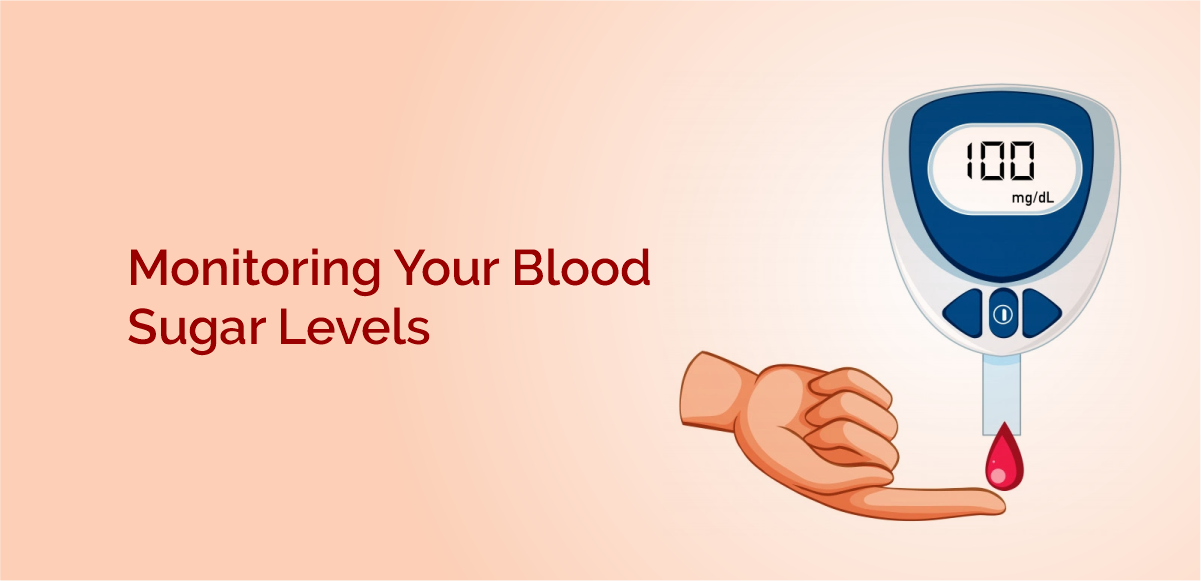

What is blood sugar monitoring?
One of the most important parts of diabetes care is to monitor your blood sugar levels regularly. It helps you understand how your body responds to certain foods, exercise, and medications. Checking your blood sugar levels regularly can help you and your doctor plan and manage your diabetes effectively.
Most people with diabetes tend to check their glucose levels at home using a portable device called a glucometer. A glucometer analyses your sugar levels by using a small amount of blood, usually from the fingertip. These glucometers only tell you your current blood sugar levels.
Why test your blood sugar?
Testing and monitoring your blood sugar levels is a vital part of diabetes management. The readings of your blood sugar levels will provide relevant prognostic and diagnostic data.
Some advantages of regular blood sugar testing:
- Recognise the high and low values of blood sugar
- Check if the progress is in line with treatment goals
- Measure the effect of medication
- Understand the direct effect of diet and exercise on blood sugar levels
- Learn how other factors such as illness and stress affect blood sugar levels
How to use a blood glucose meter at home
Since there are many variants of blood glucose meters, these instructions may not hold for all of them. Each blood glucose meter may have certain advantages over the other. It’s important to conduct research into which one will suit you best.
- Broad guidelines that may hold for most blood glucose meters are:
- Ensure the device is clean before using it. No foreign bodies or dust particles should be present on the sensor.
- Close the container that holds the test strips after removing one for the test.
- As with the device, ensure that your hands are clean. Washing your hands with soap is ideal.
- Ensure your hands, especially the tips of your fingers, are dry. There should be no moisture.
- Do not use alcohol to clean your fingers since it makes the skin dry.
- Massage your finger to get the blood moving.
- Prick your finger with a lancet.
- Place a small quantity of blood on the test strip. Squeeze the finger from the base, if required.
- Insert the strip into the meter.
- Note down the reading (it will be visible on the blood glucose meter).
- Additionally, mention any changes or deviations that could be responsible for the reading. Factors such as stress, food, physical activity, etc., can affect the readings.
- Dispose of the lancet and strip responsibly.
Irrespective of the type of blood glucose meter, never share your monitoring equipment with anyone. Not even family members. Unlike a blood pressure monitor, a blood sugar meter is a personal device. The overall accuracy of your blood sugar readings can be compromised if you share it with others.
Make sure that you use fresh lancets every time you check your blood glucose levels. Store the test strips in a dedicated container at all times. Store this container away from moisture, heat, and extreme cold.
What happens when your blood sugar levels are too low?
When blood sugar levels dip below the normal level, you may experience hypoglycemia. Hypoglycemia can be dangerous for your health. Blood sugar levels below 70 mg/dl are considered ‘low'.
Some of the symptoms of hypoglycaemia are:
- Sweating
- Hunger
- Irritability
- Anxiety
- Tiredness
- Loss of orientation
- Loss of consciousness.
Hypoglycaemia needs urgent treatment.
Consult a diabetologist immediately if you experience a hypoglycemic episode while under treatment.
What happens when your blood sugar levels are too high?
One instance of high blood sugar levels doesn’t signify anything serious. Marginally high values won’t cause any significant symptoms either. Serious symptoms appear only if blood sugar levels are extremely high, or if it continues to remain high for a prolonged period of time.
A reading greater than 180 mg/dl 2 hours after a meal is considered a high blood sugar level.
When blood sugar levels consistently remain high, it may be diagnosed as diabetes. Some symptoms of hyperglycemia are:
- Increased thirst
- Frequent headaches
- Fatigue
- Increased frequency of urination
- Dryness of mouth
Monitor your blood sugar levels to understand if they are consistently on the higher side.
These high blood sugar levels must be treated to avoid further complications such as giddiness, nerve damage, coma, and death.
When to consult a doctor
If you have experienced any symptoms of high or low blood sugar, it’s advisable to consult your doctor.
The ideal blood sugar level range as per your age, weight, lifestyle, and other factors will be explained by a doctor. The doctor can guide you about the treatment needed for high or low blood sugar levels. These may include diet, exercise, and lifestyle modifications.
The doctor will monitor your blood sugar levels with a few blood tests and a urine test. In case blood sugar levels continue to be out of the normal range, consult a diabetologist.
Blood sugar levels as a standalone figure may not give the correct picture. A single blood test will not be able to give you the correct picture.. A combination of blood tests such as blood sugar fasting, blood sugar postprandial, and HbA1c gives the doctor a better idea of your condition. Based on the doctor’s advice, you can book a diabetes package for all lab tests together.
It is preferable to share a log of your blood sugar readings, including food intake, exercise, and any other changes.
The treatment of high or low blood sugar levels can be managed when you monitor your blood sugar levels. A diary with all relevant parameters over a set time period helps give doctors the perspective needed for the correct prognosis and treatment.